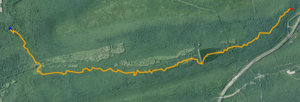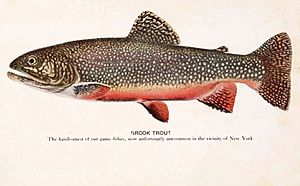Messers Run facts for kids
Quick facts for kids Messers Run |
|
|---|---|

Satellite map of Messers Run. The red dot is the stream's source and blue dot is its mouth.
|
|
| Physical characteristics | |
| Main source | Spring Mountain in Kline Township, Schuylkill County, Pennsylvania 1,600 ft (490 m) |
| River mouth | Catawissa Creek in East Union Township, Schuylkill County, Pennsylvania 1,053 ft (321 m) 40°52′39″N 76°05′47″W / 40.87745°N 76.09641°W |
| Length | 5.2 mi (8.4 km) |
| Basin features | |
| Progression | Catawissa Creek → Susquehanna River → Chesapeake Bay |
| Basin size | 5.98 sq mi (15.5 km2) |
| Tributaries |
|
Messers Run is a small stream, or tributary, located in Schuylkill County, Pennsylvania. It flows into a larger stream called Catawissa Creek. Messers Run is about 5.2 miles (8.4 km) long. It travels through two areas called Kline Township and East Union Township.
This stream is special because it's home to many fish, including brook trout and brown trout. It's known for having very clean, cold water, which is great for these fish. The area around Messers Run is mostly covered in forests, making it a beautiful natural spot.
Contents
The Stream's Journey
Messers Run starts its journey high up on a mountain called Spring Mountain in Kline Township. It begins near Interstate 81. The stream flows generally southwest at first, then turns west.
As it continues, Messers Run flows through the Lofty Reservoir. A reservoir is like a big lake made by people to store water. After leaving the Lofty Reservoir, the stream keeps flowing west. It picks up water from two smaller, unnamed streams along the way.
The stream then enters East Union Township. Here, it turns northwest and meets its only named tributary, Negro Hollow. It then passes near another reservoir called the Blue Head Reservoir. Finally, Messers Run flows for a bit longer until it joins the larger Catawissa Creek.
What are Tributaries?
A tributary is a smaller stream or river that flows into a larger one. Messers Run has three smaller streams that feed into it. Only one of these is named: Negro Hollow. Negro Hollow flows through different townships, including Delano Township, Kline Township, and East Union Township. The other two smaller streams are unnamed.
Water Quality
The water in Messers Run is generally clean and cold. However, in some parts, especially upstream of the Lofty Reservoir, the water can be a bit acidic. This means it has a lower pH level, which is a way to measure how acidic or basic water is. The stream also has some alkalinity, which helps balance the acidity.
Scientists have measured the water temperature in Messers Run. For example, on a summer day in July 1997, the water temperature was around 15.1 °C (59.2 °F) in one spot and 16.8 °C (62.2 °F) in another. This shows it stays cool, which is important for the fish that live there.
Land and Rocks Around the Stream

Messers Run starts at an elevation of nearly 1,600 feet (490 m) above sea level. By the time it reaches Catawissa Creek, its elevation is about 1,053 feet (321 m).
The land around Messers Run is made up of different types of rocks. Most of the area has rocks from the Mauch Chunk Formation. These rocks are made of things like siltstone, sandstone, and shale. There are also areas with rocks from the Pottsville Formation, which include claystone and limestone. These different rock types influence the soil and water in the area.
The main soil types found in the Messers Run area are called Leck Kill soil and Hazleton soil. These soils are important for the plants and trees that grow there.
Some parts of Messers Run, especially near its source and along its tributaries, can be prone to flooding during very heavy rains, like a 100 year flood.
The Stream's Surroundings and History
The entire area that drains water into Messers Run is called its watershed. This watershed covers about 5.98 square miles (15.5 km2). Most of this area is in Kline Township, but parts are also in East Union Township, Delano Township, and Mahanoy Township.
There are two important reservoirs on Messers Run: the Lofty Reservoir and the Blue Head Reservoir. The Lofty Reservoir is owned by the Pennsylvania Game Commission and is used to provide drinking water.
Much of the land around Messers Run is covered by forests. A large part of the stream flows through Pennsylvania State Game Lands Number 308, which are protected areas for wildlife and recreation. There is also some agricultural land (farms) in the lower parts of the watershed.
It can be a bit tricky to get to Messers Run because much of it is far from roads. Some parts are only accessible by special roads that are open only at certain times of the year.
Messers Run has been used as a water supply for people since the early 1900s. The Pennsylvania Fish and Boat Commission has studied the stream to learn more about its water and the fish that live there.
Animals in Messers Run
Messers Run is considered a "High-Quality Coldwater Fishery" by the Pennsylvania Department of Environmental Protection. This means it's a great place for fish that like cold water. Its tributary, Negro Hollow, is also a high-quality stream. Both Messers Run and Negro Hollow are special "Class A Wild Trout Waters," meaning they have healthy populations of wild trout that reproduce naturally.
Seven different kinds of fish live in Messers Run. The most common and important are brook trout. These fish are very special because they are native to this area. Other fish found in the stream include eastern blacknose dace, white suckers, pumpkinseeds, brown trout, tessellated darters, and sculpins.
Scientists study the number and size of trout in the stream. They measure the biomass of trout, which is the total weight of all the trout in a certain area. This helps them understand how healthy the trout population is. For example, in some parts of the stream, there are many brook trout, both small and large.
Fun and Recreation
Messers Run is a great place for outdoor activities, especially angling (fishing). While some parts might be harder to fish, other sections, like the area between the Lofty Reservoir and the Blue Head Reservoir, are excellent for fishing.
The stream also flows through Pennsylvania State Game Lands Number 308. These lands are open for people to enjoy nature, including hiking and observing wildlife in the forested areas.


